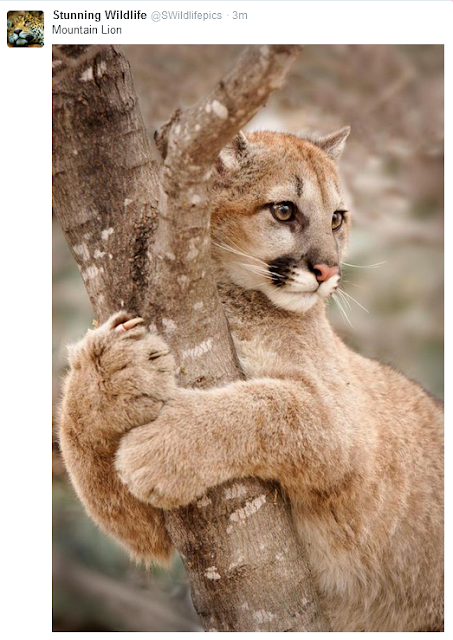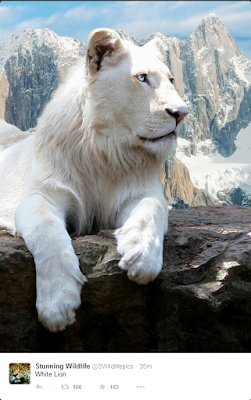Of the predators found around the world, some of the most elegant and regal are the big cats. You may be able to recognize these species at first sight, but how much do you really know about them? From the speedy cheetah to the powerful tiger, each species has qualities and quirks that makes them stand out from the rest. Here's a dose of fascinating trivia about these well-loved felids.
Cheetahs
1. Cheetahs are capable of going from zero to 40 miles per hour in only a few strides, and can hit 60 miles per hour in just three seconds. That’s an explosive power that would leave most cars in the dust. The cheetah’s top speed has been clocked at 64 miles per hour.
2. A species of cheetah was once found in North America. While it is extinct today, evidence of its existence remains in a modern species: the pronghorn. It's believed that these incredibly fast ungulates, which can sustain speeds of 30 miles per hour for miles on end, evolved their speed and endurance as a way to escape their ancient cheetah predators.
3. Cheetahs are great at getting by with little water. They only need to have a drink every three or four days.
4. Though cheetahs are fast, they aren’t perfect hunters. Only about half of their kill attempts are successful. The effort to catch prey lasts a mere 20-60 seconds, but is incredibly energy-intensive, so every missed kill is a significant amount of wasted energy.
5. Though the species is millions of years old, cheetah populations have undergone a dramatic decline in the last century. There were over 100,000 cheetahs in 1900, but only an estimated 9,000-12,000 remain in the wild today, with only 200 left in Iran.
Cougars
1. The cougar has the Guinness World Record for the animal species with the most names. It has over 40 names in the English language alone, including mountain lion, puma, catamount, ghost cat, painter, shadow cat, panther and mountain screamer.
2. The cougar cannot roar. Instead it makes chirping or yowling sounds when it needs to vocalize. And of course it has a hearty purr.
3. Cougars are ambush predators, often hiding until prey is within reach and making a powerful leap. This strategy has helped make the species' leaping ability extraordinary. The cats can jump 15 feet high in a single leap, and they can clear 40 feet in distance especially if leaping down from a vantage point above their prey.
4. While animals like deer are a staple for cougars, when food is scarce they catch whatever is edible, including insects.
5. Cougar populations are mostly stable, but there is one subspecies that is critically endangered. The Florida panther has only about 100 individuals left.
Jaguars
1. Jaguars have unique markings compared to other cats, and they have spots within spots. Actually, they're not called "spots" but rather are "rosettes" because each marking looks like a rose, with an outer dark marking and a lighter spot within that darker marking.
2. Jaguars used to be found throughout South America, Central America, and as far into North America as the Grand Canyon. However, their numbers have been decimated by habitat loss and hunting. There are now fewer than 15,000 jaguars in the wild, and they are considered an endangered species.
3. Cats are famous for their dislike of water, but the jaguar turns that stereotype on its head. This big cat enjoys water and swims, plays, hunts and even fishes in rivers and streams. There are historical accounts that jaguars dipped their tails in streams to lure fish!
4. Jaguars have the strongest jaws of any of the cat species and can bite down with 2,000 pounds of force. This is enough to pierce turtle shells and easily crunch through bones. Their bite is twice as strong as the lion; in fact, the jaguar is second only to the hyena for strongest bite of all mammals.
5. This big cat's name is derived from the Native American word yaguar, which means "he who kills with one leap," referencing the animal's incredible hunting prowess and strength.
Leopards
1. Leopards can be found throughout Africa and Asia, and have adapted to thrive in diverse environments from dense jungles to grassy savannas to deserts.
2. Females can give birth at any time of the year. The cubs — usually a litter of two — will stay with the mother for as long as two years while learning to hunt.
3. Though leopards are the smallest of the big cat species, they are pound-for-pound the strongest. Their stocky, powerful build allows them to drag large prey up into trees to keep it away from scavengers.
4. Leopards are opportunistic and will eat most things that come close enough to catch, including wild pigs, snakes, monkeys and even porcupines.
5. There are nine subspecies of leopard, all of which are near threatened, endangered or critically endangered. The Javan leopard has only an estimated 250 individuals left, and the Amur leopard has only perhaps 20 individuals left in the wild.
Lions
1. Lions are the only social species of the cat family. Members of a lion pride are typically very affectionate with each other, with plenty of cuddling and mutual grooming when they are resting. The pride also works as a team to bring down prey, which is shared with the entire group.
2. As long as food is plentiful, a female lions will stay with the pride in which she was born for her entire life. Males, however, usually leave once they reach maturity, forced out by the dominant male or males. These bachelors will sometimes form small coalitions of two or three, and seek out another pride to take over.
3. A lion's roar can be heard as far as 5 miles away.
4. If lions and tigers seem similar, that's because they are. In fact their bodies are so similar that if you disguised their coats, only experts would be able to tell which was the lion and which the tiger.
5. Lion populations have decreased by half since the 1950s. According to Panthera, "Lions have vanished from over 80 percent of their historic range. Today, the most recent surveys estimate that there are fewer than 30,000 lions living in the wild in Africa today."
Snow Leopards
1. Snow leopards have shorter front legs than back legs. The front legs (which also have larger paws than the back legs) help the cat balance and land jumps more easily. Meanwhile, the longer, powerful back legs help the cat make those impressive jumps, which can be as far as 45 feet! These features are a necessity for jumping across mountain ledges and rocky terrain while chasing down equally agile prey.
2. Snow leopards cannot roar. Rather, they hiss, mew, chuff and growl.
3. Though the snow leopard is a medium-sized cat, weighing in at between 60-120 pounds, it can still take down prey three times heavier than itself.
4. Snow leopards can travel many miles in a single night. The Snow Leopard Trust documented one cat traveling across 27 miles of open desert in one night. This same cat walked more than 93 miles in five days. Their ability to cross vast distances helps them to move between areas where prey can be found, which is sometimes sparse in their cold mountain habitat.
5. The snow leopard is endangered, with only an estimated 3,500-7,000 individuals left in the wild. Pinning down exact numbers is difficult because of the species' elusive nature. But researchers know that the population is low and in decline. Poaching, loss of habitat, loss of prey due to human encroachment, and retaliatory killings are all threats to the species.
Tigers
1. The tiger is the world's largest cat species. Males of the largest subspecies, the Siberian tiger, weigh in at between 400-675 pounds on a frame measuring 6-7.5 feet long!
2. Though the tiger is well camouflaged, stealthy and powerful, only about 1 in 10 of its attempts to bring down prey are successful. To make sure they get the most out of every kill, a tiger can eat as much as 35-90 pounds of meat in a single sitting.
3. Tigers are typically loners but there have been reports of tigers traveling in groups. In most of these cases, the tigers are probably either coming together to mate or are somehow related such as older siblings still with their mother. In any case, a group of tigers is called a "streak" or an "ambush."
4. Tigers can and do purr. But it isn't the purring we're used to. Unlike our domesticated cat, which can purr while breathing in and out, the tiger can only purr when it is exhaling. Some biologists have pointed out that the physical traits that allow tigers to roar don't provide them with the ability to purr, and while there is debate on the specificity of whether their sounds "count" as purring, studies have leaned toward the theory that they can indeed purr, just differently.
5. Tiger populations have decreased at an alarming rate in the last century. While there were around 100,000 tigers throughout their range in the early 1900s, today there are fewer than 3,200 in the wild. With poaching for their coats and other body parts used in traditional Chinese medicine (tigers have no scientifically-proven medicinal properties), habitat loss and fragmentation, and retaliatory killing by villagers among the top threats, tigers are at serious risk of going extinct. Three subspecies of tiger have gone extinct in the last 80 years alone.
By Jaymi Heimbuch
With thanks to MMN
Additional pictures via Twitter.
Some related posts:
Golden Tabby Tigers
Lion Protector, Shivani Bhalla Helps Big Cats and People Coexist
Clouded Leopard Born at Florida Zoo
World Lion Day: Some Stunning Images Of The King Of The Jungle
Two Snow Leopard Cubs Born at Brookfield Zoo
White Lions - A Royal Family
Leopard Hunting Banned in South Africa For Remainder of 2016
A Hidden Population Of Up To 200 Lions Has Been Found In Ethiopia
Tigers Are Coming Back!
Tracking Sumatran Tigers
30 Tiger Zoos In Thailand Face Nationwide Checks
The Truth Behind The Tiger Temple
The Black Panther
Russia's 'Extinct' Persian Leopards Reintroduced To Black Sea Mountains
Why Big Cat Rescue Doesn’t Have Cheetah or Jaguars
The Best Big Cat Videos Come From The Wild
Amur Tiger Release
Over 100 Tigers Killed And Trafficked Each Year
Last Wild Ocelots In Texas Get New Paths To Safety
































